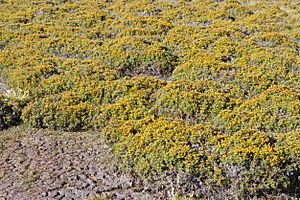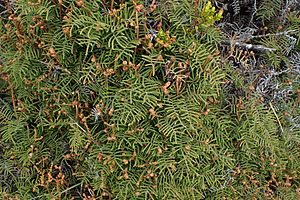Alpine coral-fern facts for kids
Quick facts for kids Alpine coral-fern |
|
|---|---|
 |
|
| Gleichenia alpina in Walls of Jerusalem National Park, Tasmania | |
| Scientific classification | |
| Genus: |
Gleichenia
|
| Species: |
alpina
|
| Synonyms | |
|
|
Gleichenia alpina, also known as alpine coral-fern, is a small type of fern. You can find it growing in Tasmania and New Zealand. This fern loves cool, damp places, especially in mountains and high-altitude areas. It belongs to a plant family called Gleicheniaceae.
A famous botanist named Robert Brown first officially described this plant in 1810.
Contents
What Does Alpine Coral-Fern Look Like?
Gleichenia alpina is a common fern that grows on the ground. It likes wet, mountainous areas. Its leaves, called fronds, branch out many times. They look a bit like a fork or antler.
A special feature of this fern is its deep pouches. These pouches are found on the underside of its small leaf segments, called pinnules. They are covered with thick, orange-brown hairs.
How to Tell it Apart from Similar Ferns
Gleichenia alpina has short frond stems. It also has many orange-brown scales that cover the underside of its leaves. These scales can turn pale over time.
This fern can sometimes be confused with another species, Gleichenia dicarpa. However, G. alpina has very rounded, pouch-like leaf segments. It also usually has fewer forks in its fronds.
Where Does Alpine Coral-Fern Grow?
This fern lives in cold, open places. It likes wet ground, such as bogs and scrublands in high mountain areas. You often see it growing among other plants. It rarely grows inside thick forests. It is often found with a plant called Empodisma.
Where Can You Find Alpine Coral-Fern?
In Tasmania
You can find Gleichenia alpina all over Tasmania's mountain regions. It grows in areas higher than 700 meters (about 2,300 feet) above sea level. Some places where it is found include the Central Plateau, Walls of Jerusalem, Cradle Valley, and Mt Field National Park.
In New Zealand
This fern is also found on both the North and South Islands of New Zealand. It has been seen in places like the Central Volcanic Plateau and the Denniston Plateau. Scientists are still studying its exact distribution in New Zealand. This is because some smaller forms of Gleichenia dicarpa can look very similar to G. alpina.


